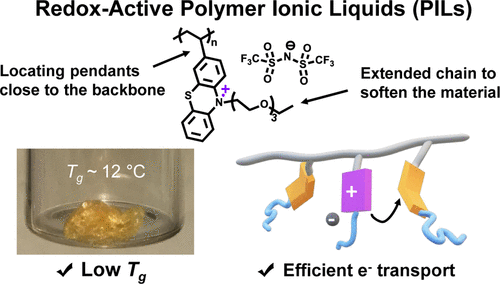当前位置:
X-MOL 学术
›
ACS Appl. Mater. Interfaces
›
论文详情
Our official English website, www.x-mol.net, welcomes your
feedback! (Note: you will need to create a separate account there.)
Redox-Active Polymeric Ionic Liquids with Pendant N-Substituted Phenothiazine
ACS Applied Materials & Interfaces ( IF 8.3 ) Pub Date : 2021-01-22 , DOI: 10.1021/acsami.0c20462 Saejin Oh 1 , Andrei Nikolaev 1 , Kan Tagami 1 , Thi Tran 1 , Dongwook Lee 2, 3 , Sanjoy Mukherjee 4 , Rachel A. Segalman 2, 4 , Songi Han 1, 2 , Javier Read de Alaniz 1 , Michael L. Chabinyc 4
ACS Applied Materials & Interfaces ( IF 8.3 ) Pub Date : 2021-01-22 , DOI: 10.1021/acsami.0c20462 Saejin Oh 1 , Andrei Nikolaev 1 , Kan Tagami 1 , Thi Tran 1 , Dongwook Lee 2, 3 , Sanjoy Mukherjee 4 , Rachel A. Segalman 2, 4 , Songi Han 1, 2 , Javier Read de Alaniz 1 , Michael L. Chabinyc 4
Affiliation

|
Polymers that are elastic while supporting charge transport are desirable for flexible and soft electronics. Many polymers with bulky and conjugated redox-active pendant units have high glass transition temperatures (Tg) in their neutral form that will not lead to elasticity at room temperature. Their behavior in charged form in the solid state without an electrolyte has not been extensively studied. Here, the design strategy of polymeric ionic liquid where two weakly interacting ionic groups are used to maintain a low Tg is shown to lead to flexible redox active polymers. The use of a flexible ethylene backbone and redox-active phenothiazine (PTZ)-based pendant group resulted in polymers with relatively low Tg that are electrically conductive. PTZ that was N-substituted with 2-(2-ethoxyethoxy)ethoxy)ethyl was found to promote solubility of the polymer and lower the Tg of the neutral polymer by ∼150 °C relative to that of the Tg of a variant without the N-substituent. Doping with trifluoromethanesulfonimide leads to an electrically conductive polymer without significantly increasing the Tg. Physical characterization by UV–vis–NIR spectroscopy, electron spin resonance spectroscopy, and impedance spectroscopy verified that the molecular design leads to an efficient charge hopping between the PTZ groups.
中文翻译:

侧链N取代的吩噻嗪的氧化还原活性聚合物离子液体
对于柔性和软电子器件而言,在支持电荷传输的同时具有弹性的聚合物是理想的。许多具有大体积和共轭氧化还原活性侧链单元的聚合物以中性形式具有较高的玻璃化转变温度(T g),这在室温下不会导致弹性。在没有电解质的情况下,它们在固态下呈带电状态的行为尚未得到广泛研究。在此,使用两个弱相互作用离子基团来维持低T g的聚合物离子液体的设计策略显示出可产生柔性氧化还原活性聚合物的能力。使用柔性乙烯主链和基于氧化还原活性的吩噻嗪(PTZ)的侧基时,聚合物的T g相对较低导电的。PTZ这是N-取代的2-(2-乙氧基乙氧基)乙氧基)乙基发现,以促进聚合物的溶解度,并降低Ť克由℃,相对〜150的中性聚合物的到的Ť克的变体,而不N取代基。用三氟甲烷磺酰亚胺掺杂可产生导电聚合物,而不会显着增加T g。通过紫外可见近红外光谱,电子自旋共振光谱和阻抗光谱的物理表征证明了分子设计可导致PTZ组之间的有效电荷跳跃。
更新日期:2021-02-03
中文翻译:

侧链N取代的吩噻嗪的氧化还原活性聚合物离子液体
对于柔性和软电子器件而言,在支持电荷传输的同时具有弹性的聚合物是理想的。许多具有大体积和共轭氧化还原活性侧链单元的聚合物以中性形式具有较高的玻璃化转变温度(T g),这在室温下不会导致弹性。在没有电解质的情况下,它们在固态下呈带电状态的行为尚未得到广泛研究。在此,使用两个弱相互作用离子基团来维持低T g的聚合物离子液体的设计策略显示出可产生柔性氧化还原活性聚合物的能力。使用柔性乙烯主链和基于氧化还原活性的吩噻嗪(PTZ)的侧基时,聚合物的T g相对较低导电的。PTZ这是N-取代的2-(2-乙氧基乙氧基)乙氧基)乙基发现,以促进聚合物的溶解度,并降低Ť克由℃,相对〜150的中性聚合物的到的Ť克的变体,而不N取代基。用三氟甲烷磺酰亚胺掺杂可产生导电聚合物,而不会显着增加T g。通过紫外可见近红外光谱,电子自旋共振光谱和阻抗光谱的物理表征证明了分子设计可导致PTZ组之间的有效电荷跳跃。











































 京公网安备 11010802027423号
京公网安备 11010802027423号